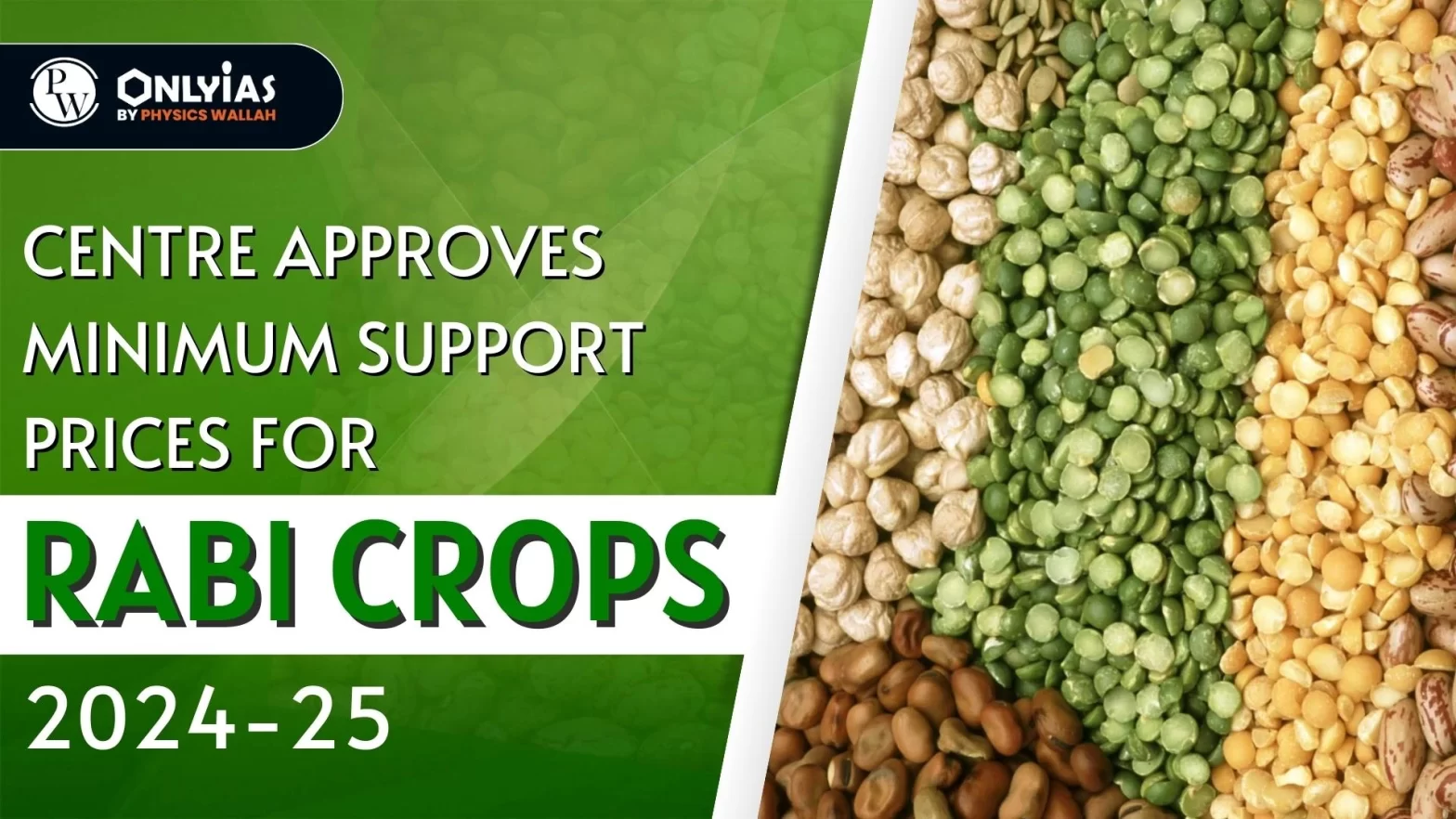Context:
| Relevancy for Prelims: Agriculture, Minimum Support Prices, Union Budget, Swaminathan committee report, Commission for Agricultural Costs & Prices (CACP), and Cabinet Committee on Economic Affairs (CCEA).
Relevancy for Mains: Government Approves Minimum Support Price (MSP) for Rabi Crops, About MSP, and how it calculated and who determined it. |
Government Approves Minimum Support Price (MSP); Key Highlights
- It is in line with the Union Budget 2018-19 announcement of fixing the Minimum Support Price at a level of at least 1.5 times of the All-India weighted average Cost of Production.
- The expected margin over the All-India weighted average Cost of Production is 102 percent for wheat, followed by 98 percent for rapeseed & mustard, 89 percent for lentil, 60 percent for gram, 60 percent for barley, and 52 percent for safflower.
- MSP for wheat has been increased by 7.1% to ₹2,275 per quintal for the rabi marketing season (RMS) 2024-25. This is the highest year-on-year increase in wheat MSP since 2012-13.
- Fixing MSP based on the Swaminathan committee report backed with statutory guarantee has been a long demand of farmer groups and was a major demand during the year-long farmers’ protest in 2021-22.
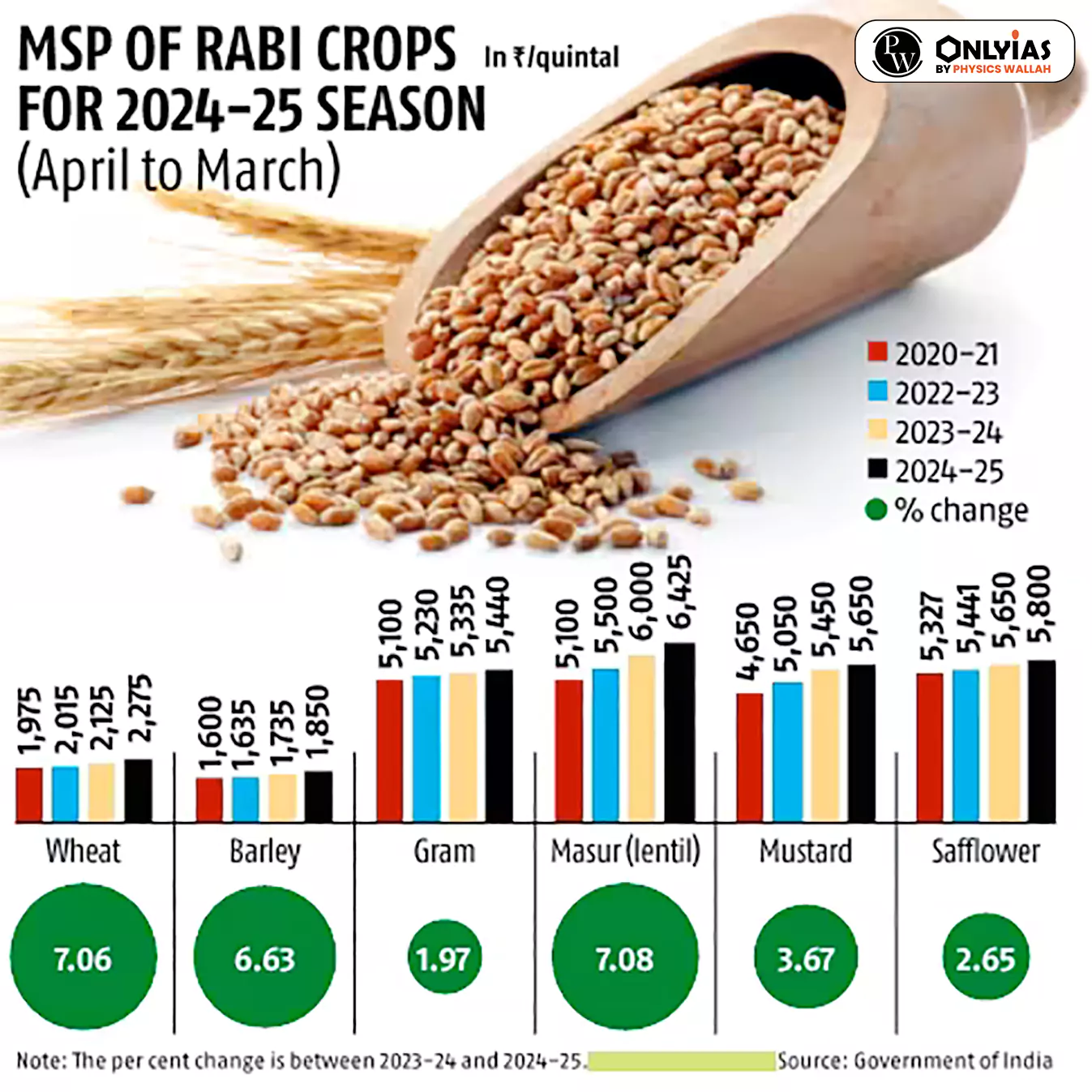
What is Minimum Support Price?
- It is a “Minimum Price” for any crop that the government considers as remunerative for farmers and hence deserving of “support.”
- It is also the price that government agencies pay whenever they procure a crop.
- The government now fixes Minimum Support Prices for 23 Crops but is NOT legally bound to pay these even if open market rates for the said produce are ruling below their announced floor prices.
How are Minimum Support Prices determined?
- The actual amount depends on the method used to calculate the cost of production (CoP).
- The government bases its announcement on the recommendations from the Commission for Agricultural Costs & Prices (CACP), which details three major formulae to arrive at Minimum Support Price. (Refer Infographics)
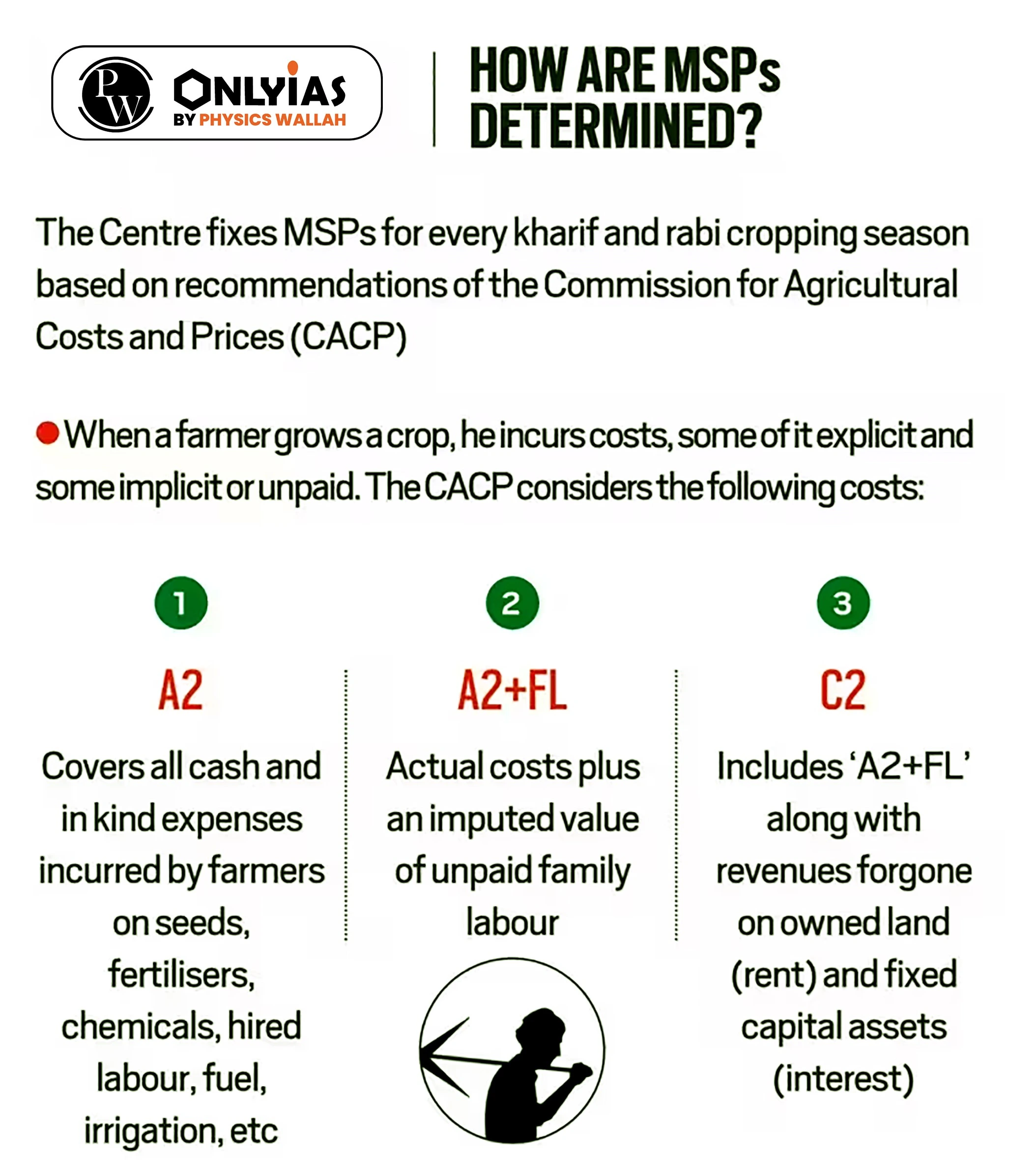
Commission for Agricultural Costs & Prices (CACP)
- It is an attached office of the Ministry of Agriculture and Farmers Welfare, Government of India. Established in January 1965.
- Mandate: It is mandated to recommend Minimum Support Prices to incentivise the cultivators to adopt modern technology, and raise productivity and overall grain production in line with the emerging demand patterns in the country.
- CACP recommends Minimum Support Prices of 23 commodities, which comprise 7 cereals (paddy, wheat, maize, sorghum, pearl millet, barley and ragi), 5 pulses (gram, tur, moong, urad, lentil), 7 oilseeds (groundnut, rapeseed-mustard, soybean, sesamum, sunflower, safflower, Niger Seed), and 4 commercial crops (copra, sugarcane, cotton and raw jute).
|
What is the National Commission of Farmers?
It is also known as the Swaminathan Commission, recommended that the Minimum Support Price should at least be 50 percent more than the weighted average CoP, which it refers to as the C2 cost. The government maintains that the MSP was fixed at a level of at least 1.5 times of the all-India weighted average CoP, but it calculates this cost as 1.5 times A2+FL.
- The Cabinet Committee on Economic Affairs (CCEA), which approved the MSP, referred to the ‘A2+FL’ costs as the cost of production on which it has based its MSP calculations.
- Below is the projected cost of production for the Rabi Marketing Season (RMS) 2024-25 for different crops based on A2+FL and C2 formulae.
| Crops |
C2 |
MSP announced (₹ / qtl ) |
MSP acc to C2+50% |
| Wheat |
1652 |
2,275 |
2,478 |
| Barley |
1614 |
1,850 |
2,421 |
| Gram |
4547 |
5,440 |
6,820.5 |
| Lentil |
4890 |
6,425 |
7,335 |
| Rapeseed & Mustard |
4068 |
5,650 |
6,102 |
| Safflower |
5414 |
5,800 |
8,121 |
- The Cabinet Committee on Economic Affairs (CCEA), which approved the Minimum Support Price, in its statement on October 18, referred to the ‘A2+FL’ costs as the cost of production on which it has based its MSP calculations.
- Now if the C2+50% formula is to be applied, the difference between the declared MSP and the one that the farmers have been demanding ranges between Rs 203 per quintal and Rs 1,380 per quintal, depending on the crop.
| Crops |
CoP (A2) (₹/qtl) |
CoP (A2+FL) |
CoP (C2) |
| Wheat |
903 |
1,128 |
1,652 |
| Barley |
758 |
1,158 |
1,614 |
| Gram |
2,651 |
3,400 |
4,547 |
| Lentil |
2,543 |
3,405 |
4,890 |
| Rapeseed & Mustard |
1,957 |
2,855 |
4,068 |
| Safflower |
2,830 |
3,807 |
5,414 |
Is the Farmers’ Demand to Legalise Minimum Support Price Justified?
Arguments Against Legalizing Minimum Support Price:
- Fiscal Burden on Government: Rice and wheat are procured by the government and distributed through the PDS at a highly subsidized issue price of Rs 3 per kg and Rs 2 per kg, while the economic cost is Rs 36 per kg and Rs 24 per kg, respectively. If MSP is legalized, the remaining crops also need to be procured and disposed of orderly.
- Storage and administrative capability: Using the current marketable surplus ratios (MSR), the expected marketed surplus (MS) of these crops is around 261 MT (Agricultural Statistics at a Glance 2019). However, the storage capacity available with the Food Corporation of India (FCI), state agencies, the Central Warehousing Corporation and the cooperative sector is only about 98 MT as per estimates by the Committee for Strengthening Negotiable Warehouse Receipts.
- High Inflation: A law barring purchases of the other 21 crops below MSPs by any private trader will also, immediately, fuel high inflation. Every one percentage point increase in MSPs leads to a 15-basis point increase in inflation.
- Market Distortions: An Minimum Support Price mechanism that ignores demand and global prices creates market distortions. If an MSP is above that market clearing price, no one from the private sector will be willing to buy. In that case, the government will have to become the buyer of last resort, or farmers will be left high and dry with no buyers for their produce, making farmers worse off.
- Export: Mandatory Minimum Support Prices will render India’s agri-exports non-competitive because the government’s assured prices are way higher than domestic and international market prices.
- Keeping MSP at 50 percent above cost C2 involves increasing the current MSP by 27-89 percent for Kharif and up to 45 percent for rabi crops.
- Cropping Pattern: MSPs have also incentivized foodgrains over other crops, giving rise to imbalances of water and land resources and shifting land away from crops such as pulses and oilseeds, necessitating costly imports.
- India, the world’s biggest vegetable oil importer, will likely buy 15.6 million metric tons of cooking oils in the 2023-24 oil year.
- WTO’s Obligation: WTO rules cap government procurement for subsidized food programs by developing countries at 10% of the total value of agricultural production based on 1986-88 prices in dollar terms.Surplus cereals can’t be exported without a subsidy, which invites the World Trade Organization (WTO) objections.
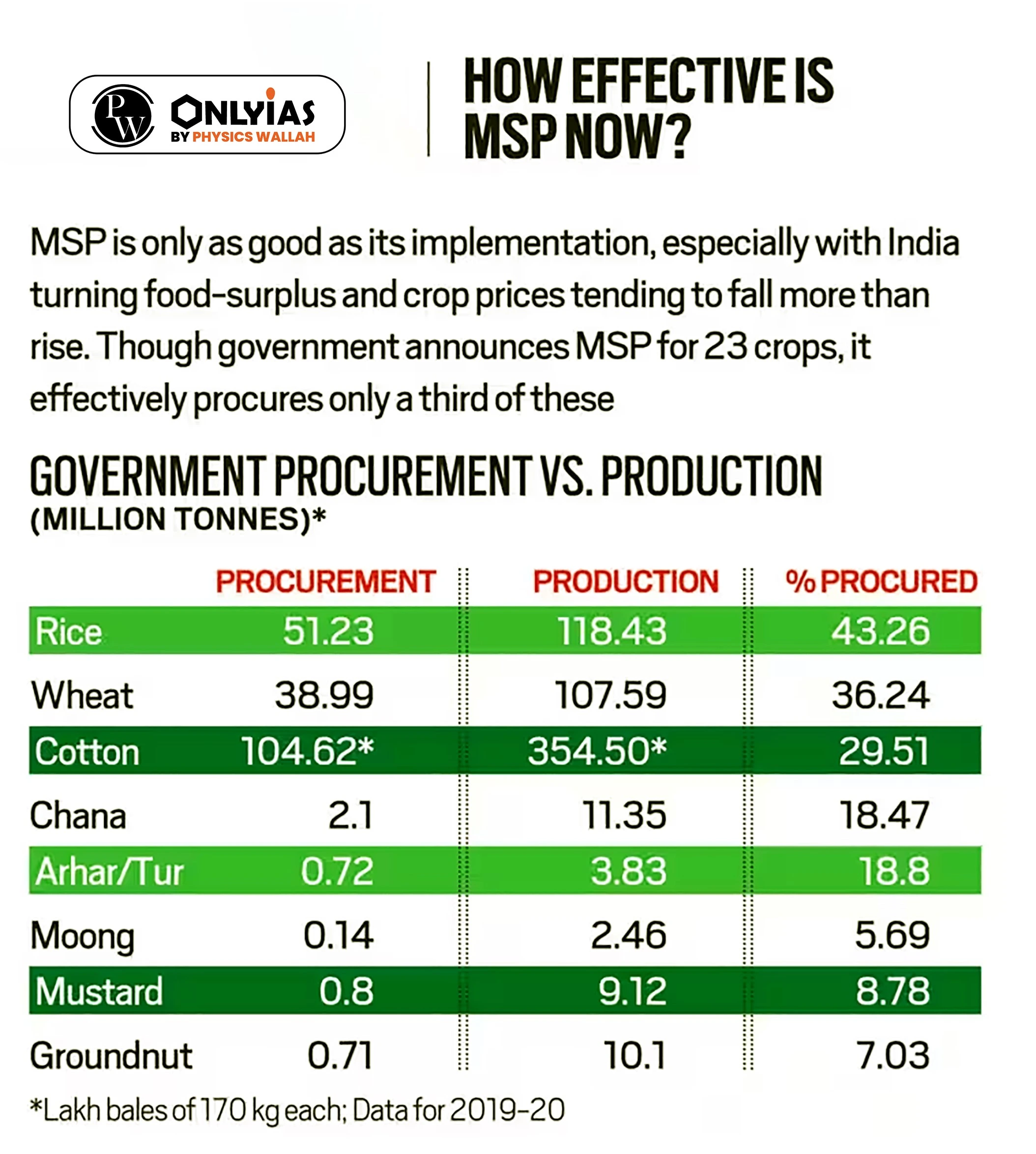
Also read: How Does Monsoon Rainfall Impact the Indian Economy?
Arguments In favour of Legalizing Minimum Support Price
- Raising Farmer’s Income: In 2018-19, the average farm household earned ₹10,218 per month (at current prices), whis was less than average national per capita income, which was ₹10,495 per month. In other words, on average, a non-farm household in India is better off than a farm household.
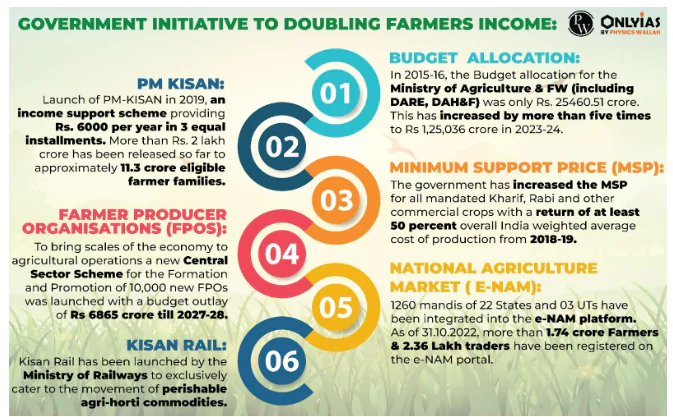
- Crop diversification: Ensuring all 23 crops are legally sold at Minimum Support Price will also lead to crop diversification as there would be no incentive to grow only those crops where MSP is now available — mostly paddy, wheat and sugarcane.
- So, the country would also come out from surplus paddy, wheat and sugarcane production situation, which will have multiple economic and ecological benefits.
- Self-sufficiency: A legal backing for Minimum Support Price is a great instrument to control the production quantities of various crops to match demand. The country could also become self-sufficient in edible oils and pulses if we ensure remunerative MSPs for these crops.
- Import dependency of pulses decreased from 19% in 2013-14 to around 9% in 2021-22; projected to drop further to around 3% by 2030-31.
- Pulses procurement up more than 74 times during 2016-21 in comparison to 2009-14 Record increase in MSP of the pulses benefiting farmers
- Reduce Fiscal Burdens: If the government and private prices are the same, farmers won’t seek out the government to purchase their crops. So the government will not be pressured to buy more than it requires.
- Food Security: The Minimum Support Price is vital in achieving food security. It encourages farmers to receive a fair price for their crops, thus motivating them to produce essential food items and contribute to a steady and sufficient food supply in the market.
- Therefore, it is important that it should continue to function with better facilities and scientific management.
Also read: PM-PRANAM Scheme
Way Forward
Dalwai Committee (2016) Recommendation for Doubling Farmers Income: The committee has observed that an increase in the Minimum Support Price could be one of the instruments for enhancing farmers’ income.
- A more straightforward, and potentially more beneficial, means of raising farm incomes could be reforming the marketing system of agricultural produce, while also developing new institutions and reviving existing ones to facilitate linking of the farmer to the markets.
Price Deficiency Schemes: The Niti Aayog has suggested a ‘Price Deficiency Payment’ system to address the gaps in Minimum Support Price (MSP) based procurement of crops.
- Price Deficiency Payment’ system wherein subsidy would be provided for targeted produce in case the price falls below the MSP threshold. All the crops will be considered for price support.
- “Bhavantar Bhugtan Yojana” the scheme paid the difference between the market price and the minimum support price to farmers
Direct Income Transfer: The idea here is to extend MSP benefits to the small and marginal farmers and in states where government procurement is currently insignificant.
- In the long run, Minimum Support Price procurement itself should be replaced with per-acre transfers. Farmers are better off with minimum “income” rather than “price” support.
- The Rythu Bandhu scheme launched by Telangana, wherein the government gives farmers an incentive of Rs 5,000 for each acre of land as an investment for the crop.
Structural and Governance Reforms in Agriculture: It includes institutional mechanisms at district, state & national levels for coordination & convergence of various government schemes, a digital monitoring dashboard at district, state & national levels for seamless & real-time monitoring of fields, utilizing Panchayat Raj Institutions, and farm income measurement as key delivery channels for transparent and inclusive development.
Agri-R&D and agricultural-extension systems: Agricultural extension is critical to improve farm productivity and to translate the same into increased income.
- Use of digital and disruptive technology such as AI, Robotics and Drone, etc. are vital in developing the sector into a major source of growth in the Indian economy.
Strategies for Sustainability in Agriculture: It is essential that sustainable agriculture is not limited to the practice of alternate production systems(such as Climate Resilient Agriculture, Rainfed Agriculture, Integrated Farming System, Organic Farming, etc.) in certain geographies alone, but goes beyond into larger cultivation practices by incorporating evidence-based and good agricultural practices.
Conclusion:
Farming over the years, for the majority, especially small and marginal farmers, has not turned out to be remunerative. A rise in their income could be the long-term answer to farmers’ financial distress.
| Prelims Question (2020)
Consider the following statements:
1. The Government of India provides Minimum Support Price for niger (Guizotia abyssinicia) seeds.
2. Niger is cultivated as a Kharif crop.
3. Some tribal people in India use niger seed oil for cooking.
How many of the above statements are correct?
(a) Only one
(b) Only two
(c) All three
(d) None
Ans: (c) |
To get PDF version, Please click on "Print PDF" button.
